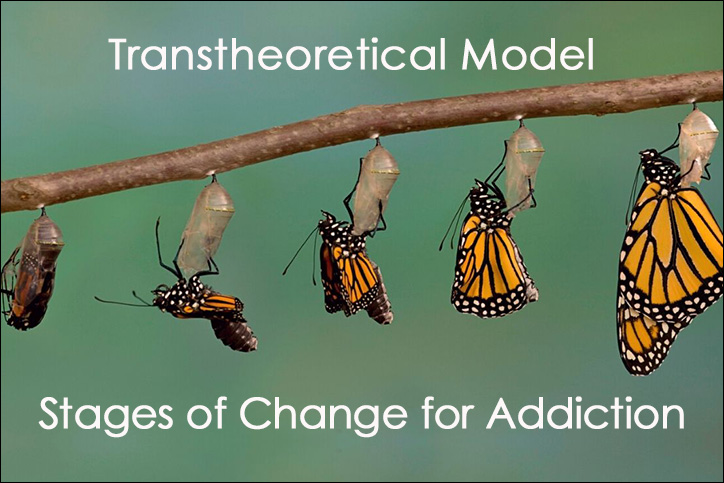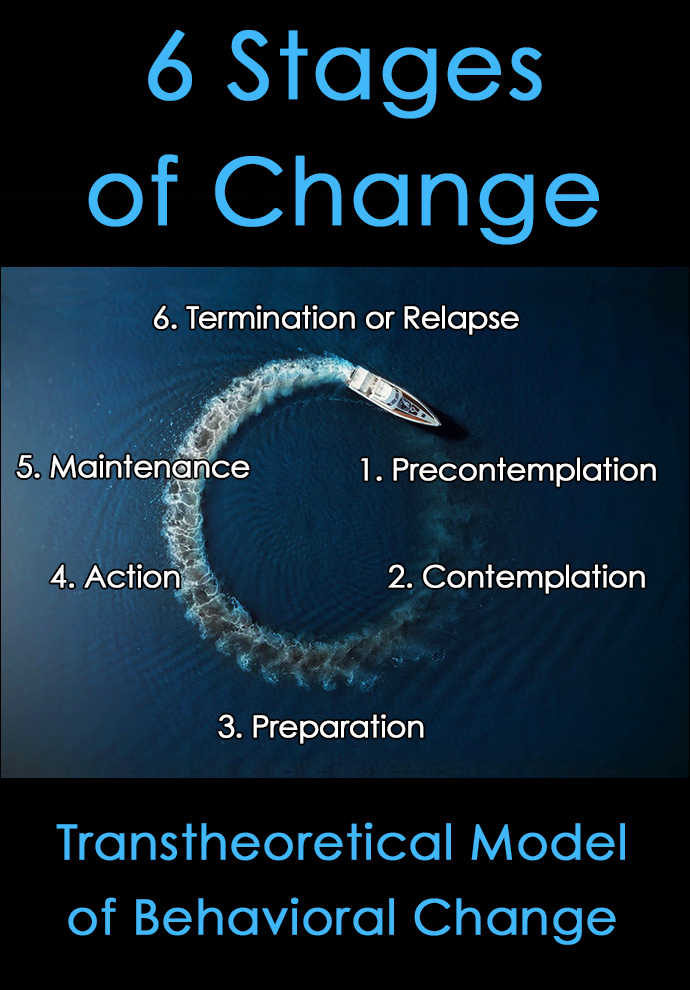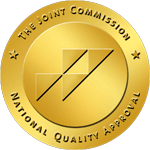Table of Contents
Addiction recovery is a process that will cycle through a series of steps or stages of change that often begin before a person recognizes the need to transform his or her behavior.
Changing deeply entrenched habits or behaviors that have turned unhealthy over time can be incredibly difficult.
While people usually decide to make a change for the better, like eating a healthy diet and exercising regularly to lose weight, it still takes a significant amount of effort, time, and emotional commitment.
Regardless of the behavior a person trying to modify, there are specific stages of change that everyone will experience, including those battling a dependency to drugs or alcohol.
Recognizing the stages of change in addiction recovery is necessary for identifying where a person is in the cycle to achieve a healthy, positive, and lasting change.
What is the Stages of Change Transtheoretical Model (TTM)?
The stages of change a person experiences are based on the Transtheoretical Model of Change (TTM) that assumes most people do not change behaviors in a quick and decisive manner.
Instead, behavioral changes, especially when a substance use disorder is present, tend to occur continuously through a repeated process.
James O. Prochaska and Carlo DiClemente developed the Transtheoretical Model in the 1970s and 1980s that outlines the various stages of change a person goes through when modifying a certain behavior for the better.
The researchers compared the experiences of smokers who gave up cigarettes on their own with those who needed additional help or treatment. They did this in order to understand why some people were able to quit on their own and others were not.
The result of their research is referred to the Transtheoretical Model of Change, which outlines six independent stages of change that a person moves through when working to change behaviors and habits.
Some practitioners only consider the first five stages to be part of the process, while others view the sixth stage of change – Termination or Relapse – as crucial for completing the entire cycle.
How Does the Stages of Change Model Work?
In essence, the stages of change model evaluates a person’s readiness to change a negative behavior into a positive one.
This can be effective for changing some types of depression, drug or alcohol addiction, smoking, and other unhealthy behaviors.
The stages of change model acknowledges that change is rarely easy and often requires small steps and a gradual progression toward the desired outcome. It also recognizes that relapses may be an unavoidable part of the cycle.
The six stages of change start with a person having little or no desire to change behavior and end with being able to maintain their new behavior, as well as stopping the need for constant treatment or assessment.
For many people, the stages of change model is most effective when they take the time to define what each of the individual stages mean for them and how their personal experiences fit into each specific category.
More importantly, understanding what stage of change an individual is in can help do the necessary work to move forward into the next stage of change.
What are the 6 Stages of Change?
1. Precontemplation
The Precontemplation stage occurs in the very beginning when a person is not even considering making a change in the foreseeable future.
During this phase, an individual might not even understand that his or her behavior is causing problems for them or their loved ones.
When they do think about change, the focus is generally on the negative aspects of change and that it might be hard or impossible.
They may also underestimate how much better their life and situation would be if they made a change.
2. Contemplation in the Stages of Change
In the Contemplation Stage of Change, a person has moved into a more positive view of change and intends to start working on a healthier behavior in the near future.
At this point, he or she may have started to understand that their unhealthy habit has created negative consequences.
While they may still focus on the negative or hard parts of change, more thought and consideration is given to the benefits.
Still, a person in the contemplation stage of change may feel conflicted or ambivalent about actually taking the next steps to toward a healthier lifestyle.
3. Preparation
Preparation is the third stage of change where a person is ready to begin the process and has usually set a date for when the change will gradually begin going into effect.
As a result, the individual might even start making small changes ahead of time, as a way to begin preparing for the challenges ahead.
4. Action
In the Action stage, a person has effectively made the change, though they might still be battling to hold onto the negative or unhealthy behavior, perhaps trying to modify it, and may even experience a relapse.
What’s notable in the Action Stage is that a person intends to keep moving forward with the new and healthier behavior.
5. Maintenance Stage of Change
During the Maintenance Stage of Change, a person has been living with the change for some time, often six months or more.
In this phase, the individual intends to maintain the new behavior and actively works to prevent a relapse, to avoid taking steps backward into previous stages.
6. Termination or Relapse
The sixth stage of change is sometimes referred to as Termination or Relapse, and they both signify different outcomes.
If a person reaches termination, he or she will view the old behavior as a thing of the past and no longer see the appeal of their old habit. They are sure they will not relapse or revert back to doing it.
For some people, especially those battling addiction, this stage of change is not always reached, but that’s okay. Staying in the maintenance stage of change can be incredibly healthy and satisfying.
Still, other people may actually relapse during the sixth stage of change. Depending on the circumstances regarding the relapse, some individuals may start over from the beginning, or revert back to one of the later stages of change, such as Action or Maintenance.
Processes of Change for the Transtheoretical Model
The Transtheoretical Model outlines the six stages of change that a person experiences as they modify a negative or unhealthy behavior.
Along the way, another important part of the model identifies 10 processes of change that include strategies or methods for enabling effective change.
10 Processes of Change
- Consciousness Raising – learning more about the behavior
- Dramatic Relief – identifying and expressing feelings and emotions about the behavior
- Self Re-evaluation – placing a positive value on how the new behavior will be beneficial
- Environmental Re-evaluation – understanding how the negative behavior impacts others
- Social Liberation – realizing that society and other people are supportive of the new behavior
- Self-Liberation – believing that achieving the healthier behavior is possible
- Counter-Conditioning – finding ways to substitute healthy behaviors for the negative behaviors that need to be changed
- Stimulus Control – changing the environment to avoid triggers that lead to the negative behavior
- Helping Relationships – seeking help from others to encourage and support changing the negative behavior
- Reinforcement Management – rewarding and celebrating positive behavior
An example for number 9 above, Helping Relationships, would be to seek professional help for alcohol addiction at an alcohol treatment facility.
Many dangerous or risky behaviors such as substance use addiction often require professional help to ensure lasting change and avoid a relapse.
The stages of change and processes of change are just two aspects of the overall Transtheoretical Model for transforming a negative behavior into a positive one, but probably the most important ones to recognize.
Understanding the stage of change a person is at when attempting to modify a negative behavior can be extremely helpful for both the individual who wants to make the change, as well as those who provide support or treatment for the person in recovery making the change.





